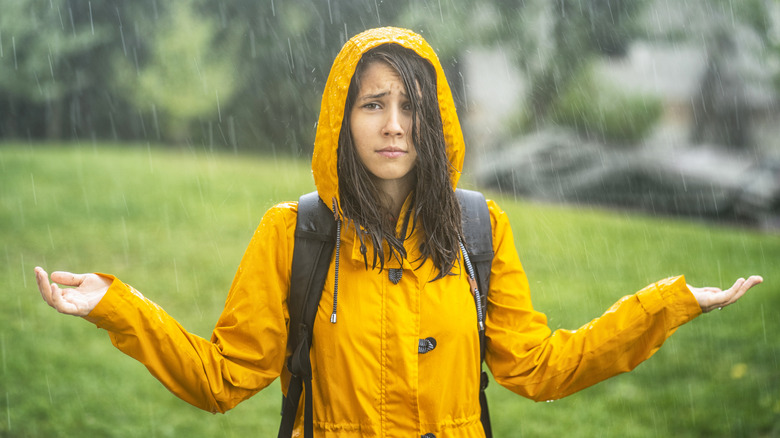This Low-Tech Camping Hack Helps You Stay Warm In The Cold After Getting Wet
Rain happens. It's just a part of being outside. Many climates are dry, of course, but pretty much every inch of the planet gets rained on at some point. Even in summer, some of the best places to hike and camp can be a total crapshoot when it comes to weather. The Pacific Northwest? Bring rain gear. New England? Waterproof boots. How about all of Canada, the second-largest country in the world? Layer up. There are lots of ways to prepare for unexpected bad weather while camping.
But when you do get soaked, your instinct may be to strip off all those wet garments and wrap yourself in something dry. That works fine if you expect sun or warmth in the foreseeable future. Yet in relentless cold and moistness, true survivalists recommend the opposite: Don't bother removing those clothes, and put on a puffy coat instead. A blog post on the Montana Knife Co. website details exactly how and why this should be done; in short, removing your wet clothes will waste time, and your exposed skin will quickly release body heat.
Instead, you need to zip yourself into a water-resistant shell, set up your tent as fast as possible, and hunker down. Sealed within your warmest outer layers, the insulation alone should stave off hypothermia. The one exception to this rule is your socks, which you may quickly replace with a dry pair. This is one of the survival skills everyone should know, no matter where you venture.
Other pitfalls and strategies for staying warm while wet
Sudden rain is one danger, especially in cold places without dry shelter, yet a worse threat is full immersion in cold water; you might trip and fall into a river, break through ice into a lake, or tumble overboard during a winter boat ride. All of these could be life-threatening situations, so you'll need to act fast. Backcountry campers likely won't have time to build a fire or change into dry clothes, and you may not even have dry clothes if your backpack got drenched alongside you. Just as important as your physical response is your mental one: Stay calm and keep breathing. Panic leads to mistakes, and "gasping" in frigid water may cause hyperventilation.
The Montana Knife Co. post recommends a number of survival techniques as well, such as consuming hot drinks and putting Nalgene bottles of hot water inside your boots to help them dry out. These should all be considered "step two," after you've insulated yourself and overcome the initial shock, and only if they're possible. If you anticipate these kinds of risks, or you just like to prepare for worst case scenarios, consider enrolling in one of these 12 save-your-skin survival schools.

